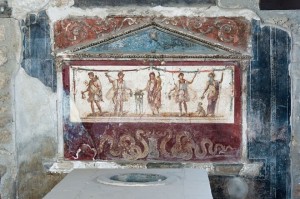Posted on December 16, 2015 | Leave a comment | Edit
Christmas is fast approaching, and dinner with family and friends is often the centerpiece of celebrations. AntiquityNOW is pleased to offer a few recipes with a past that will tickle the taste buds and fill your feast with historic meaning. Each of the dishes below has a fascinating history you can share with your family and friends. And the foods are from all over the world, so you’ll be serving a truly international and timeless meal!
- Roman Garlic Pesto (Moretum)– Enjoy an ancient Roman appetizer!
- Butternut Squash Soup with Maple Roasted Chickpeas– Yummy enough to serve as the main dish, this rich soup can be served in smaller portions as an amuse–bouche.
- Roast Chicken with Ancient Grappa– In place of the more traditional holiday ham or Christmas turkey, try this delectable chicken that will whisk you away to Old World Italy.
- Roasted Leeks and Apples– These two ancient ingredients pair beautifully to create a dish that will warm the heart and fill the belly.
- Amaranth Fritters– These golden brown, fried fritters are delicious! And they feature an ancient and nutritious leafy green.
- Christmas Pudding– No Christmas feast is complete without this classic treat. Did you know that the tradition of lighting the pudding on fire before serving it comes from the tradition of the ancient Celtic Druids who lit great bonfires at the winter solstice meant to give power to the dying sun and to hold back the approaching dark?
- Christmas Cookies– Don’t forget to leave cookies for Santa!










 Southern cuisine has deep roots in Africa. One of the most vibrant cultures contributing to the South’s identity was actually one that evolved from unintended diversity.
Southern cuisine has deep roots in Africa. One of the most vibrant cultures contributing to the South’s identity was actually one that evolved from unintended diversity.












